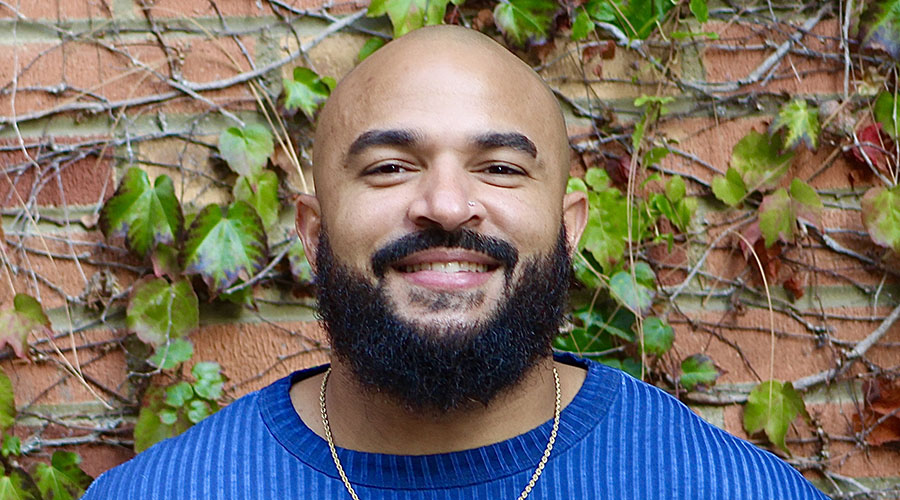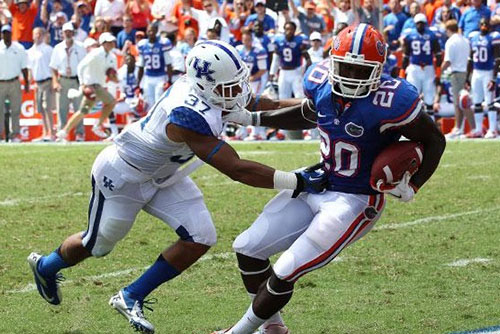After an injury derailed his athletic career, Dakotah Tyler pivoted to exoplanets.
Sophia Chen | February 16, 2024

Credit: Dakotah Tyler
Life can turn on a dime — or in the case of Dakotah Tyler, on a knee. During a home football game in September 2012 at the University of Kentucky, the 21-year-old Division I football player knocked into an opposing player, felt his knee twist the wrong way, and experienced a shock of pain.
The MRI revealed the injury: He had torn his ACL. “It was devastating to get that news,” he says. As months passed in recovery and rehab, he realized that his childhood dream of playing for the NFL was over. “I couldn’t really train anymore because I kept re-aggravating my knee injury,” he says. He had to leave his position as a safety on Kentucky’s team.
But Tyler didn’t languish. “I just know myself,” he says. “I can’t go through life and be happy if I don’t know what direction I’m going.”
As he rehabbed the injury, he watched documentaries on the stars and planets. Drawn in by the voices of Carl Sagan and Neil DeGrasse Tyson, “astronomy became this new, intense passion that I had that could take the place of football, which was so central to my life up to that point,” he says.
His world began to open up. Prior to the injury, “a lot of my identity was built around being a football player,” he says. “Football is hailed in the United States. It's one of the biggest spectacles.” The state of Kentucky didn’t have a professional football team, so the university team had an outsized cultural importance in the state. Being on the team was almost like being a celebrity. But he realized that being a football player didn’t tell him much about who he really was.

Credit: Dakotah Tyler
Dakotah (at left) in a football game in 2012. An injury that year changed his career trajectory.
“I started to think, what else was out there?” he says.
He eventually Googled, “How do you become an astrophysicist?” Graduate school, the search results said. He called the University of Cincinnati to ask how to apply, and a professor said he needed to take multiple calculus and physics courses. So after he graduated from UK in 2013 with a degree in community and leadership development, he signed up for math and science classes at Ivy Tech Community College in his hometown of Indianapolis.
At the same time, he worked for FedEx unloading boxes from planes. “I worked nights, and then I would grab a nap, and then head to class, and then come home, do homework, and then go to sleep, and wake up and go back to work,” he says.
That period was tough. In community college, he was retaking math that he never properly learned in high school, and the coursework felt far removed from his goal of being an astrophysicist. “It was a test of perseverance, of how badly I wanted it,” he says.
Lessons from the field propelled him. “In football, basically every play, you win or lose,” he says. “But when you lose, you don't throw your helmet off and go home and quit. It doesn't serve you to sulk. You line back up, and you try to win the next play.”
In 2014, Tyler moved to Cincinnati, where he took calculus, physics, and chemistry at Cincinnati State Community College while working at a pizza place. A year later, he transferred to the University of Cincinnati for a second undergraduate degree in physics and astrophysics.
During that time, he joined APS’s National Mentoring Community, where he was paired with L.C.R. Wijewardhana at the University of Cincinnati. The NMC helped him in multiple ways, he says: He gained experience presenting research at a 2018 Bridge Program and NMC conference at Stanford, and a recommendation letter from Wijewardhana helped Tyler get an undergraduate research role at the Harvard-Smithsonian Center for Astrophysics. He graduated from UC in 2019.
Tyler is now a fourth-year astrophysics graduate student at the University of California, Los Angeles, studying how planets in our galaxy evolve over time. Among the more than 5,000 exoplanets discovered, many are slightly larger than Earth (“super-Earths”), and many are slightly smaller than Neptune (“sub-Neptunes”). Few planets have sizes that fall in between. Researchers hypothesize that the planets form at more sizes, but they lose material to end up at super-Earth and sub-Neptune sizes.
Tyler researches the processes by which exoplanets lose mass. Recently, he and his collaborators published in The Astrophysical Journal their study of WASP-69b, an exoplanet about 160 light-years away. WASP-69b is slightly larger than Jupiter but only a quarter of its mass, meaning its atmosphere is “puffy,” says Tyler. Tyler’s team confirmed that the exoplanet — which is about 22 times closer to its star than Earth is to the Sun — releases gas in a 580,000 kilometer-long tail. “Its atmosphere is just getting baked away by its star,” he says.
Tyler also posts videos about science for the public on TikTok and Instagram. In many of them, he enthusiastically explains scientific concepts such as relativity and quantum mechanics. But he also shares his experiences with ADHD and produces motivational videos that draw from his perspective as a Black astrophysicist. Of the physics Ph.D.s in the US in 2018 and 2019, 1% were Black. This underrepresentation can manifest as “people being uncomfortable with me being here,” he says.
While he sees his colleagues’ discomfort as a problem for the field, he’s personally undaunted. “I’m pushing the boundary,” he says. “I’m reaching my potential.”
In one video, he presents a parable about the Andromeda Galaxy. While the galaxy is visible to the naked eye, humans long assumed it was a cloud of gas and dust, until Edwin Hubble’s observations in the 1920s. “Did Andromeda stop being a galaxy because the humans didn’t think it was one? Did it stop doing its job as a galaxy of producing a trillion stars?” he says in the video. “It didn’t stop doing its thing just because we underrated it. Just like the Andromeda Galaxy, your value is not based on the opinion on an external observer. […] You can’t let that stop you from being who you are, from doing your job in this universe.”
Sophia Chen is a writer based in Columbus, Ohio.
©1995 - 2024, AMERICAN PHYSICAL SOCIETY
APS encourages the redistribution of the materials included in this newspaper provided that attribution to the source is noted and the materials are not truncated or changed.
Editor: Taryn MacKinney
March 2024 (Volume 33, Number 2)
Articles in this Issue

